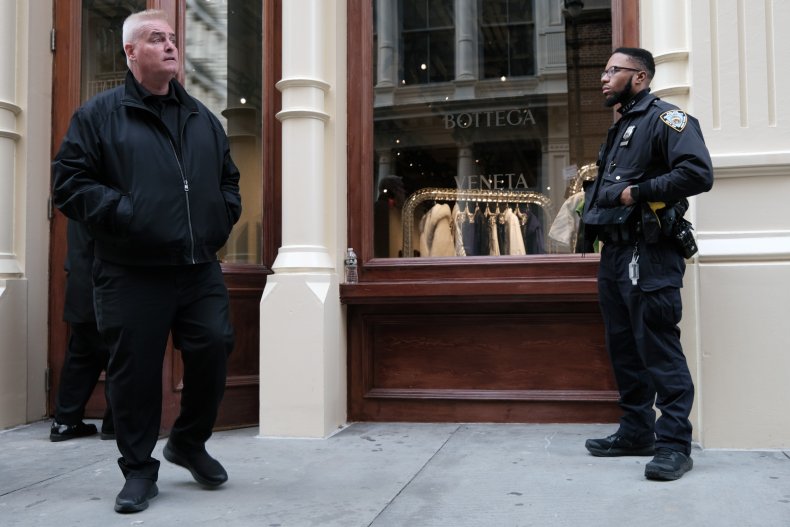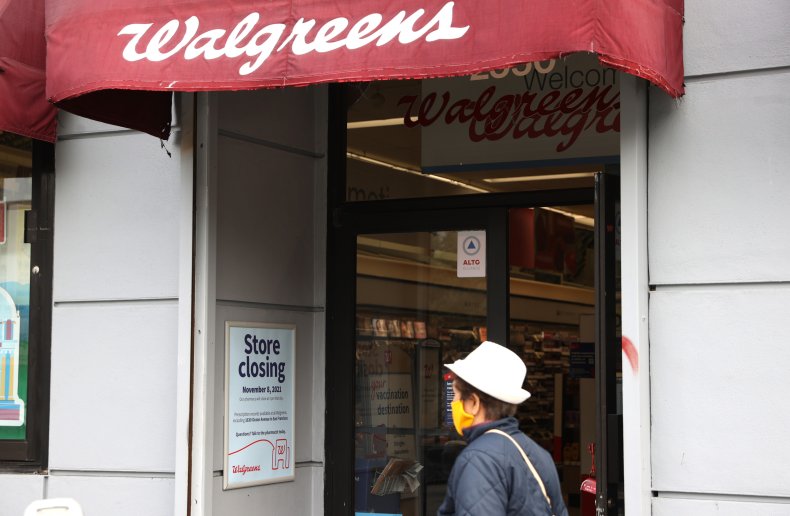
This article is more than
3 year oldThe corporate disclosure was a rare public recognition of the already large and increasing issue that theft is posing for retailers since the coronavirus pandemic. Industry insiders say that Target's figure is just the tip of the iceberg, and that shrink—a word for inventory loss—many chain stores were experiencing was largely attributable to retail crime.
"[Target is] saying it's $500 million worse than it was the year before, in 2022, and it seems like it was already bad in 2022," Jeremy Bowman, a contributing analyst at investment and consumer advice firm The Motley Fool, told Newsweek.
"It does seem like an issue that's come up in other earnings calls and commentary, certainly with drug stores," he said, citing Walgreens.

While one might think that the issue had arisen due to inflationary pressures pushing more people to shoplift, experts say that petty theft usually accounted for a small proportion of inventory loss. Large sums were being lost through organized retail crime (ORC)—something every consumer has likely experienced the effects of.
They portrayed a vicious cycle in which the pandemic had turbocharged a move towards online shopping, which itself incentivized a greater amount of retail crime, but that retail crime was now also incentivizing more consumers to shop online.
Newsweek reached out to several large retailers about the issue, including Target, Costco, Best Buy and T.J. Maxx, the latter of which declined to comment. Those that responded—Walgreens and Home Depot—confirmed it was a key issue for their companies but declined to offer figures on the scale of the losses they were experiencing.
'Professional' Gangs Stealing in Bulk
In May, a Lululemon store in Georgia made headlines after footage of staff confronting a group of three young men attempting to rob the store of bundles of clothing emerged. Two of the workers were later fired by the company over the incident; many retailers discourage staff from becoming physically involved with shoplifters.
As recently as last Sunday, a video of a "mob" raiding what was purported to be a Nordstrom in Los Angeles, grabbing clothes, handbags and suitcases went viral, earning millions of views.
Mob of 30 robbers just looted Nordstrom in Los Angeles, California 😳 pic.twitter.com/ISKqhVYHqT
— BAY AREA STATE OF MIND (@YayAreaNews) August 13, 2023
These may be obvious incidents of ORC in its simplest sense, but not the costliest to retailers, according to Tony Sheppard, a Houston-based loss prevention consultant who spent 25 years working in security and organized retail crime units for several large retailers.
Instead, the incidents that hurt shops the most are the more complex crimes carried out by professional criminal gangs who "steal in bulk," he told Newsweek.
Sheppard said the proportions of the sources of shrink had changed drastically over the last 10 years, going from "internal theft"—employees taking items—being the most predominant cause of inventory loss to external theft by organized criminal gangs.
"External theft...was a small chunk; it was always there, but it was a smaller piece of the pie," Sheppard said. "What's happened is, is that with the increase in organized retail crime, the sheer volume of product that an individual or group can take in any given day has just gone crazy."
He added: "But then you see on the news, you have all these groups that are come in and they're haphazard. They're very unorganized. A lot of younger folks just coming in grabbing stuff running out and all that stuff.
"That's certainly an impact and no doubt about it—and those are the ones that potentially, unfortunately, can become violent, which is obviously the biggest concern. But they're a sliver of that [pie]," he said.

The senior director of loss prevention at ThinkLP estimated that established criminals can steal up to $10,000 in products from a store in some cases, and can often do so without customers noticing.
The established gangs are even able to get stolen products back into the supply chain, he said, and those operating at the highest levels usually knew in advance the quantity of a specific product that needed stealing and the price they would receive for it.
"There're fences that have cleaners, and they clean the product, or they remove stickers or stamps—anything that identifies it as being from a specific retailer—and then they repackage it," Sheppard said. "Then it gets mixed in with legitimate product and sometimes ends up back in the supply chain."
In September, the National Retail Federation estimated the total cost of shrink in the United States to be $94.5 billion in 2021, with the organization's Vice President Mark Mathews noting the "burgeoning threat" of ORC. In 2019, prior to the pandemic, the Centre for Retail Research put the total shrink at $43.3 billion, of which it said just over $4.8 billion was due to organized crime.
In its first-quarter earnings call on May 16, Richard McPhail, chief financial officer of Home Depot, revealed that the company's gross margin had decreased by eight basis points compared to the same time last year, which he said was "primarily driven by increased pressure from shrink."
Evelyn Fornes, a spokesperson for the company, told Newsweek she could not divulge financial details, but said that ORC was "an ongoing issue, and it has been on the rise over the last several years for many retailers."
She added that among the "most targeted items" by criminal gangs that the home improvement chain stocked were power tools, home automation products and wiring devices.
"Retail crime is one of the top challenges facing our industry today," Marty Maloney, a Walgreens spokesperson, told Newsweek. "We are focused on the safety of our patients, customers and team members. We continue to take preventative measures to safely deter theft and aim to deliver the best patient and customer experience."
Consumers Paying the Price
With margins being eaten away by theft, among other factors, it is only natural that some businesses may increase their prices. Bowman said rising costs were certainly an impact on consumers who were "already in an inflationary environment" following the pandemic.
But there are other, obvious signs of the effects of ORC on consumers. Both Bowman and Sheppard noted the various anti-theft devices shops employed to make stealing harder, such as security cases and "pushers," which allow only one product to be removed at a time, making stealing large quantities of items more difficult.
"A lot of these stores, you walk into them and buy something like razors or a popular item," Bowman said. "You see it behind plexiglass and it's locked up, and you've got to go find an employee to unlock it."
Sheppard said retailers aim to "make it difficult for the thief, but still convenient for the legitimate consumer" as using anti-theft devices made shopping harder and therefore "obviously has a detrimental impact to sales," especially when stores are short-staffed.

As well as some customers being witness to or potentially caught up in instances of shoplifting, Sheppard explained that ORC gangs would usually hit several shops of the same type in the same area to increase the number of items they could steal in a single day, causing localized shortages of specific products.
In areas where ORC activity was high, he said, companies may choose to close stores, posing a "significant impact" on the convenience of going shopping, citing Walgreens' 2021 decision to shut five shops in San Francisco, California, due to shoplifting.
All three of these factors pushed more consumers to shop online.
In response to the mention of chain stores that had recently gone into administration, such as Bed Bath & Beyond, Sheppard said ORC was not the sole reason such companies were folding but "it's certainly a factor" in their collapse.
Generally, though, "it definitely does impact the retailer's bottom line...and they wouldn't be talking about it on the stock calls if it wasn't a significant problem," he added.
The Vicious Cycle
As is borne out by the apparent more-than-doubling of shrink between 2019 and 2022, ORC has surged during and in the aftermath of the pandemic. While Sheppard expected there to be more petty theft as a consequence of a rising cost of living, he said the predominant effect of the global crisis on the crime that retailers are subject to was pushing more sales online.
"Covid caused a significant spike in ORC in the U.S., and not necessarily for the reasons you may think as far as people being out of work," he explained. "A lot of customers that would normally never shop online, were forced to shop online, because they wouldn't leave their house...or they wanted something that wasn't non-essential."
"So you had a massive uptick in people making online purchases, which is where a lot of the stolen product ends up," Sheppard added. "So, therefore, the activity skyrocketed to meet the demand from the consumer."
He said ORC had been "steadily increasing prior to that," but that a "perfect storm" of online demand and concerns over liability for injuries sustained during shoplifting encounters had made it go "off the rails."

Whereas in the past someone stealing items for resale would have to do so in person and likely for a significant markdown on the label price, criminals can sell their stolen wares online much closer to the original price—and will often be taken up on the offer by consumers looking for a bargain.
"Your return on investment for being a shoplifter—especially a professional shoplifter who does it all the time—is way more lucrative than it used to be," Sheppard said. "It's much easier to resell the product, and the profit margin you're getting per item has just skyrocketed because of online platforms."
To make matters worse, ORC drives more consumers to shop online through the impacts on in-store shoppers it causes—localized stock issues, in particular—in turn giving resellers of stolen goods even more customers.
"It kind of feeds itself," Sheppard said.
"In the longer term, broader sense I think this will just push more businesses to the online channel," Bowman said. "If you think of a company like Amazon, they don't really have stores. I imagine there are some instances of employee theft, but you're not going to have an organized crime ring with exposure to the public in the way brick-and-mortar stores do."
He added, though, that stolen goods being sold online was "a hard thing for individual consumers to fight [with] their own hands" as "even a company the size of Amazon has problems with counterfeit goods on their site" that prompted it in April to set up a program to combat instances on its platform.
Fornes called on Congress and individual states to properly enforce the INFORM Consumers Act, which came into effect in late June and gives online transactions greater transparency, and create "capacity for law enforcement to investigate and prosecute cases through funding federal, state and local task forces."